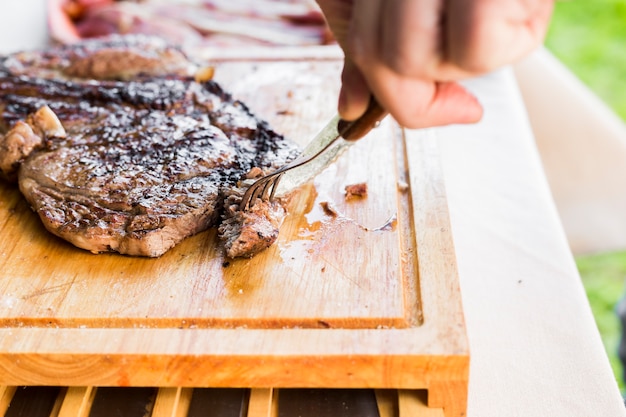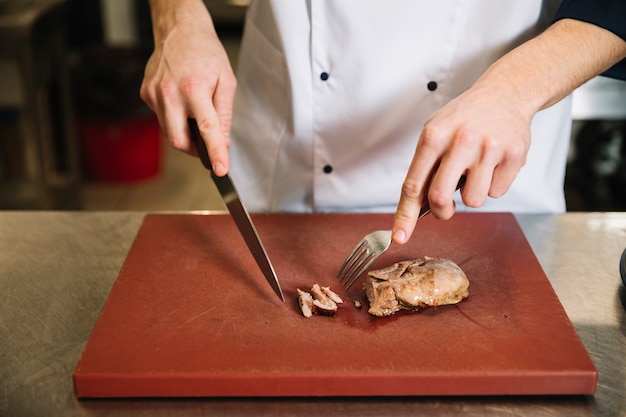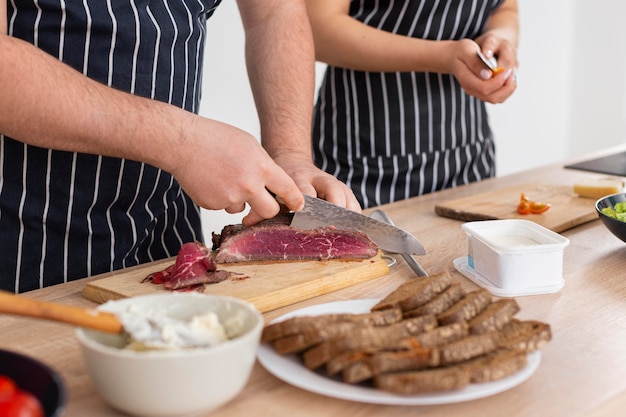Let's face it, there's nothing quite like a perfectly cooked filet mignon. The tender, juicy centre, the crisp sear on the outside, the rich aroma that fills your kitchen... It's pure culinary bliss! I've spent a fair bit of time in my life trying to master this dish, experimenting with different techniques and recipes, and trust me, there's nothing quite like the satisfaction of nailing it. This article is your guide to achieving that perfect filet mignon, the kind that makes your guests gasp and leaves them wanting more. We'll cover everything from choosing the right cut to nailing the sear, the perfect cooking time, and even a few tips on serving it up like a pro. So, grab your apron, gather your ingredients, and let's get started!
(Part 1) Choosing the Right Filet Mignon

The journey to a perfect filet mignon begins with selecting the right cut. It's like choosing the foundation of a house; if you start with something dodgy, the final result will be less than spectacular.
1.1. The "Filet" Factor
First things first, understand that "filet mignon" refers to the tenderloin, the most tender muscle of the beef. It's a long, narrow cut, usually coming from the smaller end, which is often considered the most tender. However, you can also find centre-cut or larger end pieces. These variations can be slightly less tender, but still delicious. The key is to look for a cut that's nicely marbled, meaning it has a good amount of fat running through the muscle. This fat will render during cooking, adding flavour and keeping the meat juicy.
1.2. Size Matters
The size of your filet mignon is crucial, especially if you're cooking for more than one person. A single, large filet mignon is easier to cook evenly than several smaller ones. I find that a cut between 1.5 and 2 inches thick is ideal. This thickness allows for a nice, even sear and ensures that the centre is cooked to your desired doneness.
1.3. Grade Expectations
The quality of the beef directly impacts the final flavour and tenderness. Opting for a higher grade like Prime or Choice will yield the most delicious results. These grades indicate the marbling and maturity of the beef, making them ideal for special occasions. Prime is the highest grade, with the most marbling and the most intense flavour. Choice is the next grade down, still a great option, and often more readily available.
If you're on a budget, you can also find filet mignon in the Select grade. While it may not be as marbled as Prime or Choice, it can still be quite delicious with the right cooking technique.
1.4. The Butcher's Expertise
Don't be afraid to ask your butcher for help! They're experts in choosing the best cuts of meat and can give you advice on the best filet mignon for your needs. Explain how you plan to cook it, how many people you're serving, and what level of doneness you prefer. They can help you select the perfect cut for a truly memorable dining experience.
(Part 2) The Art of Seasoning

Next up, seasoning. Now, I know what you're thinking: "Salt and pepper, right? Done." But, hold your horses. It's not as simple as it seems. Seasoning is more than just throwing salt on the meat, it's about creating layers of flavour that complement the natural richness of the beef.
2.1. The Salt Game
Salt is your best friend. But don't just dump it on at the last minute! Salt your filet mignon generously about 30 minutes before you cook it. This process, called "dry brining," draws moisture from the meat, which then redistributes, making it more tender and juicy. Plus, the salt adds flavour, so don't be shy. You want to use kosher salt for this process. It's larger crystals dissolve more slowly, allowing for even seasoning.
2.2. Pepper Power
Freshly ground black pepper is a must. Don't use the pre-ground stuff from the supermarket, it lacks that sharp, invigorating flavour that we're aiming for. I recommend using coarse black peppercorns; they'll add texture and a nice bite. Grind them just before you season the meat to release their full flavour.
2.3. Spice Up Your Life
Now, this is where you can get creative. You can add a touch of your favourite spices to complement the beef. I love a sprinkle of smoked paprika for a bit of smokiness, or a pinch of garlic powder for an extra flavour kick. Some folks even use a bit of onion powder. Be careful not to go overboard though, you don't want to overwhelm the natural taste of the meat. Remember, the star of the show is the beef!
(Part 3) mastering the sear

The sear is crucial for achieving that perfect crust. It's a quick and intense cooking method that locks in the juices and adds flavour. This browning reaction, known as the Maillard reaction, creates complex flavour compounds that enhance the taste of the meat.
3.1. Hot, Hot, Hot
Start with a screaming hot pan. cast iron pans are excellent for searing, but you can use a stainless steel pan as well. Make sure it's really hot before you add the meat. You want the pan to sizzle immediately when you touch it.
3.2. Oil It Up
A good quality cooking oil is a must. I prefer to use grapeseed oil for its high smoke point, but you can also use avocado oil or olive oil. Coat the pan generously, making sure the entire surface is covered.
3.3. The Sear Technique
Once the pan is hot, add the filet mignon. Don't overcrowd the pan, cook them in batches if necessary. Let the meat sit undisturbed for about 3-4 minutes per side, until you see a beautiful, golden-brown crust forming. Don't move it around too much. Let it sit and develop that crust. You'll know it's ready when it easily releases from the pan.
3.4. Don't Move It Too Much
This is a common mistake. Resist the temptation to poke and prod at the meat. Moving it too much will prevent a proper sear and may even lead to sticking.
(Part 4) Baking to Perfection
Once the filet mignon is seared, it's time to move it to the oven for a gentle, even cook. This is where you'll achieve the perfect balance of tender, juicy centre and a perfectly crisp crust.
4.1. Oven Temperature
Preheat your oven to 400°F (200°C). This is the sweet spot for a delicious, evenly cooked filet mignon. Too hot, and it'll burn before it's cooked through. Too low, and it'll take ages to cook and the meat might get dry.
4.2. Baking Time
The cooking time depends on the thickness of your filet mignon and the level of doneness you desire. Here's a general guideline:
| Doneness | Cooking Time (minutes) |
|---|---|
| Rare | 8-10 |
| Medium Rare | 10-12 |
| Medium | 12-15 |
Remember, this is just a guide. Use a meat thermometer to ensure your filet mignon reaches your desired doneness.
4.3. Resting is Key
Once the filet mignon is cooked, it's important to let it rest for about 10 minutes before slicing. This allows the juices to redistribute throughout the meat, resulting in a more tender and flavorful steak. This is especially important for thicker cuts.
(Part 5) Sauce, Sauce, Sauce!
A good sauce can elevate your filet mignon to another level. It adds complexity, richness, and a touch of acidity that balances the richness of the meat.
5.1. Simple is Best
Don't overcomplicate it. A simple sauce made with pan drippings is often the best complement to a perfectly cooked filet mignon.
5.2. Pan Sauce 101
Here's a quick and easy pan sauce recipe:
- While the filet mignon rests, pour off any excess fat from the pan.
- Add a tablespoon of butter and a tablespoon of chopped shallots to the pan. Cook over medium heat for a couple of minutes, until the shallots soften.
- Add a tablespoon of red wine vinegar to the pan and cook for another minute, until the vinegar is reduced.
- Pour in a cup of beef broth and bring to a simmer. Scrape the bottom of the pan with a wooden spoon to deglaze it and incorporate any flavorful bits.
- Add a tablespoon of fresh thyme leaves and a pinch of salt and pepper.
- Simmer the sauce for 5-7 minutes, until it has thickened slightly.
This simple sauce is a classic for a reason. It's rich, flavorful, and complements the beef beautifully.
5.3. Other Sauce Options
If you're feeling adventurous, there are many other sauce options you can try. A classic béarnaise sauce is a rich and creamy accompaniment, while a simple red wine reduction can add a touch of complexity and acidity.
(Part 6) Serving Up Your Masterpiece
Now, you've got a beautiful, perfectly cooked filet mignon. It's time to present it with panache!
6.1. Slice with Style
Slice your filet mignon against the grain. This means cutting perpendicular to the muscle fibres, making it easier to chew and release the flavour.
6.2. Plate It Up
Arrange the slices on a warm plate. Drizzle generously with your pan sauce, and don't be afraid to add a few sprigs of fresh herbs for a touch of colour and aroma.
6.3. side dish Symphony
Choose a side dish that complements the flavour of the filet mignon. I love a creamy mashed potato or a simple salad with a tangy vinaigrette. You can also add a touch of sweetness with roasted vegetables.
Here are a few side dish ideas that pair well with filet mignon:
- roasted asparagus with lemon and garlic
- Creamed spinach
- Truffle fries
- risotto with mushrooms and Parmesan cheese
- roasted brussels sprouts with bacon
The key is to choose sides that don't overpower the delicate flavour of the beef.
6.4. Wine Pairing
Of course, no filet mignon dinner is complete without a glass of wine. I find that a full-bodied red wine like Cabernet Sauvignon or Merlot pairs beautifully with the richness of the meat. Other great options include Zinfandel, Shiraz, or Malbec.
If you prefer white wine, try a Chardonnay or a Sauvignon Blanc with a bit of oak.
(Part 7) The Finishing Touches
Here's where you can really impress your guests with a little something extra.
7.1. A Pinch of Salt
Right before serving, sprinkle a little bit of flaky sea salt on top of the filet mignon. This will add a touch of crunch and a burst of saltiness that elevates the flavour profile.
7.2. A Swirl of Butter
A pat of cold, unsalted butter melted on top of the filet mignon is a simple yet decadent finishing touch. The butter melts into the warm meat, adding richness and a luxurious flavour.
7.3. A Sprinkle of Herbs
Fresh herbs add a touch of vibrancy to the dish. A sprinkle of chopped parsley, chives, or tarragon adds a delightful aroma and a bit of colour to the plate.
(Part 8) Tips for Success
Here are a few additional tips to ensure your filet mignon is a triumph:
8.1. Don't Overcook It
The key to a delicious filet mignon is to cook it to your desired doneness, but don't overcook it! Overcooked filet mignon is dry and tough. Use a meat thermometer to ensure it reaches your desired temperature.
8.2. Let It Rest
Resist the urge to slice into your filet mignon immediately after cooking. Let it rest for 10 minutes to allow the juices to redistribute. This will make the meat more tender and juicy.
8.3. Clean Your Pan
Clean your pan immediately after cooking. The leftover bits of food can burn onto the pan, making it difficult to clean later.
8.4. Cook in Batches
If you're cooking multiple filet mignon, cook them in batches. This ensures that each steak has enough room in the pan to sear properly and doesn't get overcrowded.
(Part 9) FAQs
Here are some common questions about cooking filet mignon:
9.1. Can I Grill a Filet Mignon?
Absolutely! Grilling is a great way to cook filet mignon. Just make sure your grill is hot and clean before you cook the meat. Use a meat thermometer to check for doneness.
9.2. What Happens If I Overcook My Filet Mignon?
Overcooked filet mignon will be dry and tough. If you accidentally overcook it, try slicing it thinly and topping it with a rich sauce to add moisture. You can also try making a steak sandwich, which can mask the dryness.
9.3. Can I Cook a Filet Mignon in a slow cooker?
While you can technically cook filet mignon in a slow cooker, it's not recommended. slow cooking tends to make the meat tough and chewy.
9.4. How Do I Store Leftover Filet Mignon?
Leftover filet mignon can be stored in an airtight container in the refrigerator for up to 3 days.
9.5. Can I Freeze Filet Mignon?
Yes, you can freeze filet mignon. Wrap it tightly in plastic wrap and then place it in a freezer-safe bag. Frozen filet mignon can last for up to 3 months.
And there you have it! Your guide to making the perfect oven-baked filet mignon. Remember, practice makes perfect. Don't be afraid to experiment, try different techniques, and find what works best for you. Most importantly, enjoy the process and the delicious results. Happy cooking!
Everyone is watching

How to Cook Frozen Lobster Tails Perfectly: A Step-by-Step Guide
RecipesLobster. Just the word conjures up images of lavish meals, special occasions, and a taste of luxury. But let's...

Pigs in a Blanket Cooking Time: How Long to Bake for Perfect Results
RecipesAh, pigs in a blanket. Just the name conjures up images of those delightful little parcels of crispy pastry en...

Pork Fillet Cooking Time: How Long to Cook It Perfectly
RecipesPork fillet, or tenderloin as it's sometimes called, is a real favourite in our house. It's so versatile, and...

The Ultimate Guide to Tender, Juicy Pulled Pork
RecipesRight, let's talk pulled pork. It's one of those dishes that just screams "comfort food," doesn't it? I mean...

The Ultimate Guide to Cooking Sweet Potatoes: From Roasting to Mashing
RecipesSweet potatoes. Just the name conjures up images of warm, comforting dishes, bursts of vibrant color, and a to...
